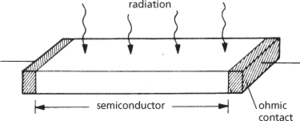See photoelectric cell.
See photoelectric cell.
A device for measuring or detecting light or other electromagnetic radiation, since its electrical state is altered by the effect of light. In a photoemissive cell, the radiation causes electrons to be emitted and a current to flow (photoelectric effect); a photovoltaic cell causes an electromotive force to be generated in the presence of light across the boundary of two substances. A photoconductive cell, which contains a semiconductor, increases its conductivity when exposed to electromagnetic radiation.
Photocells are used for photographers' exposure meters, burglar and fire alarms, automatic doors, and in solar energy arrays.
A light–electric transducer. The term was originally short for photoelectric cell, which is a vacuum diode containing a photocathode and an anode. When the photocathode is illuminated electrons are emitted. The electrons are driven to the anode by a positive potential, the driving potential, applied to the anode and a photocurrent flows in the external circuit. The small current flowing when the device is not illuminated, but the driving potential is on, is the dark current.
The term is now most commonly used to designate a photoconductive cell, which consists of semiconductor material sandwiched between two ohmic contacts (see diagram). The semiconductor may be either bulk material in the form of a rod or bar or a thin polycrystalline film on a glass substrate. The conductivity of the sample increases markedly when it is subjected to light or other radiation of suitable wavelength (see photoconductivity) and a photocurrent, superimposed on the small dark current, flows in an external circuit. The gain of such a device is defined as:
where ΔI is the incremental current due to photoconductivity (the photocurrent), e is the electron charge, and Gpair the number of electron-hole pairs created per second.
The term photocell is also sometimes applied to a photodiode or a photovoltaic cell. The resistance of photocells drops markedly upon illumination and the dark resistance – i.e. the resistance when the devices are not illuminated – is much higher than the dynamic resistance of the devices.

Photoconductive cell
- factor space
- factor theorem
- Factor VIII
- Factory Acts
- factory farming
- factory system
- fact-value distinction
- fact/value distinction
- facula
- faculae
- facultative
- facultative anaerobe
- faculty psychology
- FAD
- Fadden, Sir Arthur William (1895–1973)
- FADEC
- fader
- fading
- faecal pellet
- faeces
- Fagan inspection
- Faget, Max (1921–2004)
- fahlband
- Fahrenheit, (Gabriel) Daniel
- Fahrenheit, Gabriel Daniel (1686–1736)